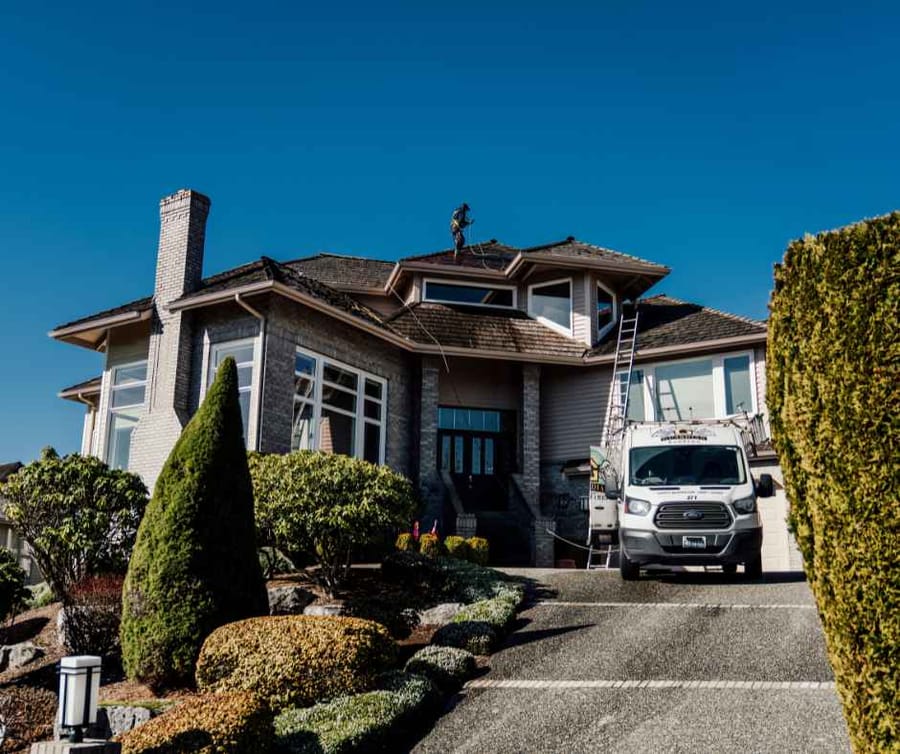Your roof is one of the biggest investments you’ll make in your home—so it’s only natural to wonder how long it will last. Composite roofing has become a popular option for homeowners thanks to its durability, affordability, and attractive appearance. But understanding its expected lifespan is key to planning for long-term maintenance or eventual replacement. Without that knowledge, you could face unexpected repairs or even costly water damage down the road.
Whether you’re installing a new composite roof or assessing the health of an older one, it’s important to know what to expect. In this blog, we’ll cover how long composite roofs typically last, what factors affect their lifespan, how to recognize signs of aging, and what you can do to help yours last as long as possible.
How Long Do Composite Roofs Typically Last?
Composite roofs—sometimes called synthetic or engineered shingles—are made from a blend of materials like fiberglass, recycled plastics, and asphalt. These materials are designed to mimic the look of traditional shingles, slate, or wood shake, but with added durability and weather resistance.
On average, a well-installed composite roof can last 20 to 50 years, depending on the product quality, local climate, and how well it’s maintained. Higher-end composite shingles may even come with warranties that extend up to 50 years or more, making them an appealing long-term investment.
Composite roofing is especially popular with homeowners who want a balance of performance, style, and affordability. It’s also favored in regions where roofs need to endure strong UV exposure, storms, or heavy rainfall—conditions where traditional roofing materials might wear out faster.
However, longevity depends heavily on two key factors: proper installation and quality materials. A poorly installed roof, even with the best shingles, won’t live up to its full potential. That’s why working with an experienced contractor like Guardian Roofing, Gutters & Insulation is so important when installing or replacing your roof.
Signs Your Composite Roof Is Nearing the End of Its Life
Even the most durable composite roof won’t last forever. Over time, exposure to the elements can wear down materials, making your home more vulnerable to leaks, damage, and energy loss. Knowing what to look for can help you catch roofing issues before they become costly problems.
Warning Signs to Watch For
If you notice any of these signs, your composite roof could be reaching the end of its useful life:
-
Curling, cracked, or missing shingles – These are clear indicators of material fatigue or storm damage.
-
Granule loss – If you see bald spots or granules in your gutters, the protective surface of your shingles may be breaking down.
-
Dark streaks or moss growth – These often point to moisture issues or algae buildup, which can shorten a roof’s lifespan.
-
Leaks or water stains indoors – Water marks on your ceiling or walls are signs that moisture is making its way past your roof.
-
Sagging or uneven rooflines – Structural problems can occur when roofing materials age or become waterlogged.
-
Frequent repairs – If you’re constantly patching leaks or replacing shingles, it might be time for a full roof replacement.
What Causes Composite Roofs to Wear Out
Several common factors contribute to the breakdown of composite roofing materials:
-
UV exposure and heat – Prolonged sunlight can dry out and weaken shingles, especially on south-facing slopes.
-
Severe weather – Hail, high winds, and heavy rain can crack or dislodge shingles.
-
Poor ventilation – Inadequate airflow in your attic can trap heat and moisture, accelerating roof deterioration.
-
Lack of maintenance – Skipping routine inspections or letting minor damage go unchecked can shorten roof life.
-
Low-quality materials or installation – Cheap materials or inexperienced installation may lead to premature roof failure.
How to Maximize the Life of a Composite Roof
A composite roof is a durable choice, but even the best materials need care to live up to their full potential. With the right habits and regular upkeep, you can extend your roof’s life and avoid costly issues down the road.
Steps You Can Take at Home
There are several simple, proactive steps homeowners can take to help protect their roof and get the most out of it:
-
Clear your gutters regularly – Clogged gutters can cause water to back up under your shingles, leading to moisture damage.
-
Trim nearby trees – Overhanging branches can scrape and damage shingles or drop debris that causes mold or moss buildup.
-
Inspect your roof each season – A quick visual check after storms or during seasonal changes can help you catch missing shingles or other issues early.
-
Look for signs of moss or algae – These organisms trap moisture and slowly degrade roofing materials. Clean any growth promptly.
-
Replace damaged shingles quickly – Even a few broken or missing shingles can lead to leaks and rot if ignored.
When to Call a Professional Roofer
Some roofing needs go beyond basic home maintenance. Here’s when it’s time to bring in the experts at Guardian Roofing, Gutters & Insulation:
-
Schedule annual inspections – Professional roofers can spot small issues homeowners might miss.
-
Get a roof cleaning – Moss, algae, and buildup can be safely removed by pros using the right methods.
-
After major storms – A professional checkup can uncover hidden storm damage that might void your warranty if left unreported.
-
If your roof is 20+ years old – At this point, inspections should be more frequent, and you may want to start planning for replacement.
-
When you see widespread wear – If repairs are becoming more frequent, a full roof replacement may be more cost-effective than ongoing patchwork.
Additional Tips to Extend Your Roof’s Lifespan
While routine maintenance plays a big role in how long your composite roof lasts, a few extra steps can make a noticeable difference. These tips help support the overall health of your roof and protect your investment for the long haul.
-
Schedule regular roof maintenance – Having a roofing professional inspect and maintain your roof once a year helps catch and fix small issues early.
-
Ensure proper attic ventilation – Good airflow reduces heat buildup and moisture, both of which can deteriorate shingles over time.
-
Upgrade your insulation – Insulation doesn’t just lower energy bills—it also protects your roof by minimizing temperature extremes beneath it.
-
Use algae-resistant shingles – Especially useful in humid or shady areas, these can prevent streaks and growth that shorten roof life.
-
Choose quality materials and expert installation – A well-made roof starts with good products and an experienced team like Guardian Roofing, Gutters & Insulation.
By combining smart homeowner habits with expert care, you can help your composite roof perform reliably for decades.
Protect Your Home With a Long-Lasting Composite Roof
A composite roof is a solid investment for long-term home protection, offering both durability and visual appeal. But like any part of your home, its performance depends on how well it’s maintained and when repairs are handled. Knowing the average lifespan—20 to 50 years—and staying alert to signs of wear can help you make smart, timely decisions.
From seasonal maintenance to expert inspections, taking a proactive approach to your roof’s care can add years to its life—and save you money in the process. If your composite roof is starting to show signs of aging, don’t wait until it turns into a leak or major repair.
Contact Guardian Roofing, Gutters & Insulation today to schedule a professional roof inspection or maintenance service. We’ll help you extend the life of your roof and keep your home protected from the top down.

